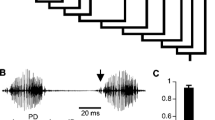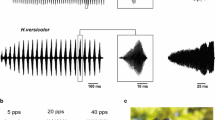Summary
-
1.
The call-timing algorithm of the white-lipped frog,Leptodactylus albilabris, was studied in the field using playback of conspecific advertisement calls (‘chirps’) recorded with a digital electronic device developed for these studies.
-
2.
A call refractory period is present. The interval between the onsets of successive chirps from one individual is always greater than this period of time.
-
3.
Call timing is characterized further by a delayed, post-stimulus inhibition period during which a subject does not initiate a chirp. The calling gap produced by this delayed inhibition seems to be necessary for continued chorusing, and thus may be an important component of intraspecific communication in this species.
-
4.
Calling males show spontaneous chirp interval distributions that suggest an underlying periodic call oscillator with noise or random variability.
-
5.
Call timing was investigated also in one individual ofLeptodactylus melanonotus. Data from this frog suggest that call timing in this species also involves a noisy periodic call oscillator, a refractory period, and delayed, post-stimulus inhibition.
Similar content being viewed by others
References
Alexander RD (1975) Natural selection and specialized chorusing behavior in acoustical insects. In: Pimentel D (ed) Insects, science, and society. Academic Press, New York
Allan DM (1973) Some relationships of vocalization to behavior in the Pacific treefrog.Hyla regilla. Herpetologica 29:366–371
Brattstrom BH, Yarnell RM (1968) Aggressive behavior in two species of leptodactylid frogs. Herpetologica 24:222–228
Bucher TL, Ryan MJ, Bartholomew GA (1982) Oxygen consumption during resting, calling, and nest building in the frogPhysalaemus pustulosus. Physiol Zool 55:10–22
Chua L (ed) (1987) Special issue on chaotic systems. Proc IEEE 75:977–1136
Duellman WE (1967) Social organization in the mating calls of some neotropical anurans. Am Midl Nat 77:156–163
Emlen ST, Oring IW (1976) Ecology, sexual selection, and the bullfrog. Behav Ecol Sociobiol 1:283–317
Foster WA (1967) Chorus structure and vocal response in the Pacific treefrog.Hyla regilla. Herpetologica 23:100–104
Hardy DF (1959) Chorus structure in the striped chorus frog,Pseudacris nigrita. Herpetologica 15:14–16
Jameson DL (1954) Social patterns in the leptodactylid frogsSyrrhophus andEleutherodactylus. Copeia 1954:36–38
Lemon RE (1971) Vocal communication by the frogEleutherodactylus martinicensis. Can J Zool 49:211–217
Lewis ER, Narins PM (1985) Do frogs communicate with seismic signals? Science 227:187–189
Littlejohn MJ, Loftus-Hills JJ (1968) An experimental evaluation of premating isolation in theHyla ewingi complex (Anura:Hylidae). Evolution 22:659–663
Littlejohn MJ, Martin AA (1969) Acoustic interaction between two species of leptodactylid frogs. Anim Behav 17:785–791
Littlejohn MJ, Watson GF (1974) Mating call discrimination and phonotaxis by females of theCrinia laevis complex (Anura:Leptodactylidae). Copeia 1974:171–175
Loftus-Hills JJ (1971) Neural correlates of acoustic behavior in the Australian bullfrogLimnodynastes dorsalis (Anura:Leptodactylidae). Z Vergl Physiol 74:140–152
Loftus-Hills JJ (1974) Analysis of an acoustic pacemaker in Strecker's chorus frog,Pseudacris streckeri (Anura:Hylidae). J Comp Physiol 90:75–87
Lopez PT, Narins PM, Lewis ER, Moore SW (in press) Acoustically-induced call modification in the white-lipped frog,Leptodactylus albilabris. Animal Behav
MacNally RC (1984) On the reproductive energetics of chorusing males: costs and patterns of call production in two sympatric species ofRanidella (Anura). Oikos 42:82–91
Martof BS, Thompson EF Jr (1958) Reproductive behavior of the chorus frog,Pseudacris nigrita. Behaviour 13:243–257
Narins PM (1982) Behavioral refractory period in neotropical treefrogs. J Comp Physiol 148:337–344
Narins PM, Capranica RR (1978) Communicative significance of the two-note call of the treefrogEleutherodactylus coqui. J Comp Physiol 127:1–9
Rosen M, Lemon RE (1974) The vocal behavior of spring peepers,Hyla crucifer. Copeia 1974:940–950
Ryan MJ, Tuttle MD, Taft LK (1981) The costs and benefits of frog chorusing behavior. Behav Ecol Sociobiol 8:273–278
Schwartz JJ, Wells KD (1985) Intra- and interspecific vocal behavior of the neotropical treefrogHyla microcephala. Copeia 1985:27–38
Sullivan BK (1985) Male calling behavior in response to playback of conspecific advertisement calls in two bufonids. J Herpetol 19:78–83
Tuttle MD, Ryan MJ (1981) Bat predation and the evolution of frog vocalizations in the neotropics. Science 214:677–678
Wells KD (1977) The social behaviour of anuran amphibians. Anim Behav 25:666–693
Zelick RD, Narins PM (1985) Characterization of the advertisement call oscillator in the frogEleutherodactylus coqui. J Comp Physiol A 156:223–229
Author information
Authors and Affiliations
Rights and permissions
About this article
Cite this article
Moore, S.W., Lewis, E.R., Narins, P.M. et al. The call-timing algorithm of the white-lipped frog,Leptodactylus albilabris . J. Comp. Physiol. 164, 309–319 (1989). https://doi.org/10.1007/BF00612991
Accepted:
Issue Date:
DOI: https://doi.org/10.1007/BF00612991




